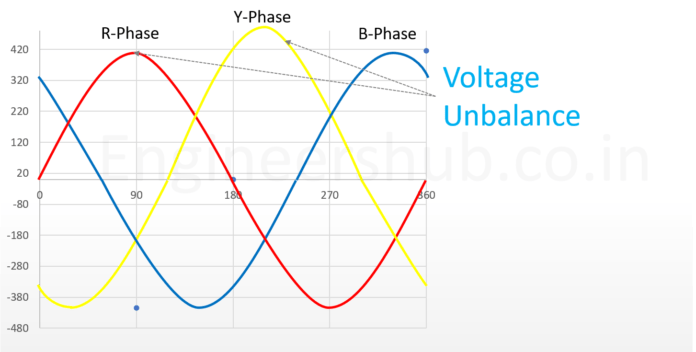What is Voltage Unbalance?
At most basic, voltage unbalance is the condition when the voltages in all three phases are not equal. The voltages altogether three phases ought to have a similar amplitude and phase-shifted by 120° one another. Voltage unbalance occurs if any of these two conditions not meet.
However, voltages are seldom perfectly balanced between the phases but they should not be excessive.
What Causes Voltage Unbalance?
Voltage unbalance can be from three different sources,
- The utility.
- The factory where motors are running.
- The motor itself.
Reasons for voltage unbalance due to the utility are:
- Lack of symmetry in a transmission line.
- Large single-phase loads (for example arc furnaces, welding machines, etc.).
- Faulty power factor correction capacitor bank.
- Open-delta transformer.
- Open-delta voltage regulator.
- Unbalance single-phase load distribution among the three phases.
Reasons for voltage unbalance due to factory or facility or plant:
- Mismatched transformer taps.
- Unbalanced single-phase load distribution among the three phases within the factory.
The causes of voltage unbalance due to the motor itself are:
- Irregular impedance due to resistive and inductive imbalance can cause voltage and current unbalance.
- Improper or damaged power circuit connections and motor lead contacts.
- Rotor and stator winding.
Standards for Voltage Unbalance
Commonly three different standards have gained popularity in defining the limits of voltage unbalance. Unfortunately, all of them have variations in limiting values for voltage unbalance.
The IEC 61000-3-x series give limits for unbalance voltage by <2% for LV and MV system. For the HV system, the given limit for unbalance voltage is <1%.
American National Standard ANSI C84.1 recommends that the power system should be designed such that the maximum voltage unbalance should not exceed more than 3%.
Above all mentioned standards and their recommended limits for voltage unbalance, NEMA MG-1-2016 is very stringent. Its recommended limit for the maximum allowed voltage unbalance is 1%. This is very hard to achieve for power utilities and facilities.
Further NEMA MG-1-2016 states that 1% of voltage unbalance can create 6-10% of current unbalance.
This discrepancy brings confusion among power utilities, customers, and motor manufacturers. However, if utilities and motor manufacturers mention the standards they follow, confusion can be avoided. Customers can also make careful consideration to avoid confusion.
What are the Effects of Voltage Unbalance?
NEMA says that Voltage imbalance can have a big impact on electrical devices and systems:
Reduced Efficiency:
Unbalanced voltages may result in the less-than-ideal operation of motors and other equipment, which may increase power consumption and running expenses.
Overheating:
Voltage unbalances result in uneven power distribution among the phases, which causes motors, transformers, and other electrical components to heat up more quickly. This can shorten the lifespan of the device, deteriorate the insulation, and cause premature failures over time.
Torque oscillations:
Voltage imbalance in three-phase motors can lead to torque oscillations, which produce mechanical vibrations and noise. The performance of the system as a whole may be impacted, and there may be excessive wear and tear.
Uneven Lighting:
Voltage imbalance in lighting systems can cause changing brightness or flickering in lamps, which can impair visual comfort.
How to Check for Voltage Unbalance?
It is easy to check for the voltage balance. There are two different approaches to check voltage unbalance.
- First is the manual one. What you have to do is, just measure all three-phase voltages at the motor terminal. Note down it. Take out the average of all measured line-line voltages. The following formula can help you further.
% Voltage Unbalance = (Maximum deviation from average voltage / Average Value) X 100
2. You can use Fluke’s MDA 500 series motor drive analyzers. This will give you real-time data of voltage unbalance.
Consider the standard that your facility follows and check whether the unbalance crossed its allowed limit mentioned in that particular standard.
Also see, How to calculate Voltage Unbalance?
Solution to Voltage Unbalance
If you have detected voltage unbalance next is to eliminate it. Follow these steps to eliminate the problems caused by voltage unbalance –
1. Load Balancing
Voltage imbalance calls for a thorough strategy that includes both preventive measures and corrective procedures. The following are some methods to reduce voltage unbalance:
By appropriately structuring the electrical system and connecting single-phase loads across various phases, load balancing distributes loads uniformly across all phases. This method aids in avoiding voltage unbalance in the first place.
2. Monitoring and Maintenance
Keep a close eye on the system’s current usage and voltage levels. To find and fix any problems causing the voltage to unbalance, carry out routine maintenance checks, such as inspections, tightening of connections, and calibration of safety devices.
3. Use of Automatic Voltage Regulator
Voltage regulators should be used to maintain balanced voltages, particularly in locations where voltage variations or deviations are common. By automatically adjusting voltages to optimum levels, these devices reduce the effects of electrical system imbalance.
4. Correction of the power factor
Power factor improvement might assist lessen voltage imbalance. To reduce the reactive power and voltage fluctuations brought on by unbalanced loads, capacitor banks might be placed.
Conclusion
Electrical systems and equipment are significantly challenged by voltage unbalance. We can prevent and lessen the effects of voltage unbalance by being proactive and recognizing its sources and effects. A stable and effective power distribution system must be maintained by the use of voltage regulators, load balancing, regular monitoring, and adequate maintenance. We can improve the dependability, efficiency, and durability of electrical infrastructure by correcting voltage unbalance.






